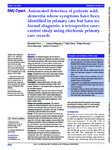Automated detection of patients with dementia whose symptoms have been identified in primary care but have no formal diagnosis: a retrospective case–control study using electronic primary care records
| dc.contributor.author | Ford, E | |
| dc.contributor.author | Sheppard, J | |
| dc.contributor.author | Oliver, S | |
| dc.contributor.author | Rooney, P | |
| dc.contributor.author | Banerjee, Sube | |
| dc.contributor.author | Cassell, JA | |
| dc.date.accessioned | 2021-11-05T10:52:47Z | |
| dc.date.available | 2021-11-05T10:52:47Z | |
| dc.date.issued | 2021-01-22 | |
| dc.identifier.issn | 2044-6055 | |
| dc.identifier.issn | 2044-6055 | |
| dc.identifier.other | e039248 | |
| dc.identifier.uri | http://hdl.handle.net/10026.1/18221 | |
| dc.description.abstract |
<jats:sec><jats:title>Objectives</jats:title><jats:p>UK statistics suggest only two-thirds of patients with dementia get a diagnosis recorded in primary care. General practitioners (GPs) report barriers to formally diagnosing dementia, so some patients may be known by GPs to have dementia but may be missing a diagnosis in their patient record. We aimed to produce a method to identify these ‘known but unlabelled’ patients with dementia using data from primary care patient records.</jats:p></jats:sec><jats:sec><jats:title>Design</jats:title><jats:p>Retrospective case–control study using routinely collected primary care patient records from Clinical Practice Research Datalink.</jats:p></jats:sec><jats:sec><jats:title>Setting</jats:title><jats:p>UK general practice.</jats:p></jats:sec><jats:sec><jats:title>Participants</jats:title><jats:p>English patients aged >65 years, with a coded diagnosis of dementia recorded in 2000–2012 (cases), matched 1:1 with patients with no diagnosis code for dementia (controls).</jats:p></jats:sec><jats:sec><jats:title>Interventions</jats:title><jats:p>Eight coded and nine keyword concepts indicating symptoms, screening tests, referrals and care for dementia recorded in the 5 years before diagnosis. We trialled machine learning classifiers to discriminate between cases and controls (logistic regression, naïve Bayes, random forest).</jats:p></jats:sec><jats:sec><jats:title>Primary and secondary outcomes</jats:title><jats:p>The outcome variable was dementia diagnosis code; the accuracy of classifiers was assessed using area under the receiver operating characteristic curve (AUC); the order of features contributing to discrimination was examined.</jats:p></jats:sec><jats:sec><jats:title>Results</jats:title><jats:p>93 426 patients were included; the median age was 83 years (64.8% women). Three classifiers achieved high discrimination and performed very similarly. AUCs were 0.87–0.90 with coded variables, rising to 0.90–0.94 with keywords added. Feature prioritisation was different for each classifier; commonly prioritised features were Alzheimer’s prescription, dementia annual review, memory loss and dementia keywords.</jats:p></jats:sec><jats:sec><jats:title>Conclusions</jats:title><jats:p>It is possible to detect patients with dementia who are known to GPs but unlabelled with a diagnostic code, with a high degree of accuracy in electronic primary care record data. Using keywords from clinic notes and letters improves accuracy compared with coded data alone. This approach could improve identification of dementia cases for record-keeping, service planning and delivery of good quality care.</jats:p></jats:sec> | |
| dc.format.extent | e039248-e039248 | |
| dc.format.medium | Electronic | |
| dc.language | en | |
| dc.language.iso | en | |
| dc.publisher | BMJ Publishing Group | |
| dc.subject | dementia | |
| dc.subject | health informatics | |
| dc.subject | geriatric medicine | |
| dc.subject | primary care | |
| dc.subject | delirium cognitive disorders | |
| dc.subject | old age psychiatry | |
| dc.title | Automated detection of patients with dementia whose symptoms have been identified in primary care but have no formal diagnosis: a retrospective case–control study using electronic primary care records | |
| dc.type | journal-article | |
| dc.type | Journal Article | |
| dc.type | Research Support, Non-U.S. Gov't | |
| plymouth.author-url | https://www.webofscience.com/api/gateway?GWVersion=2&SrcApp=PARTNER_APP&SrcAuth=LinksAMR&KeyUT=WOS:000614460700032&DestLinkType=FullRecord&DestApp=ALL_WOS&UsrCustomerID=11bb513d99f797142bcfeffcc58ea008 | |
| plymouth.issue | 1 | |
| plymouth.volume | 11 | |
| plymouth.publication-status | Published | |
| plymouth.journal | BMJ Open | |
| dc.identifier.doi | 10.1136/bmjopen-2020-039248 | |
| plymouth.organisational-group | /Plymouth | |
| plymouth.organisational-group | /Plymouth/Faculty of Health | |
| plymouth.organisational-group | /Plymouth/Faculty of Health/Peninsula Medical School | |
| plymouth.organisational-group | /Plymouth/Faculty of Health/Peninsula Medical School/PMS - Manual | |
| plymouth.organisational-group | /Plymouth/REF 2021 Researchers by UoA | |
| plymouth.organisational-group | /Plymouth/REF 2021 Researchers by UoA/UoA03 Allied Health Professions, Dentistry, Nursing and Pharmacy | |
| plymouth.organisational-group | /Plymouth/Users by role | |
| plymouth.organisational-group | /Plymouth/Users by role/Academics | |
| plymouth.organisational-group | /Plymouth/Users by role/Researchers in ResearchFish submission | |
| dc.publisher.place | England | |
| dcterms.dateAccepted | 2020-12-23 | |
| dc.rights.embargodate | 2021-11-6 | |
| dc.identifier.eissn | 2044-6055 | |
| dc.rights.embargoperiod | Not known | |
| rioxxterms.versionofrecord | 10.1136/bmjopen-2020-039248 | |
| rioxxterms.licenseref.uri | http://www.rioxx.net/licenses/all-rights-reserved | |
| rioxxterms.licenseref.startdate | 2021-01-22 | |
| rioxxterms.type | Journal Article/Review |


